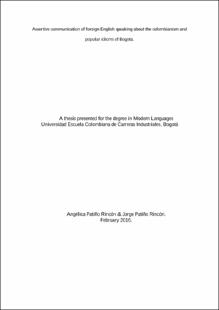Mostrar el registro sencillo del ítem
Assertive communication of foreign English speaking about the colombianism and popular idioms of Bogota.
| dc.contributor.advisor | García Ardila, Alexis | |
| dc.contributor.author | Patiño Rincón, Angélica María | |
| dc.contributor.author | Patiño Rincón, Jorge Luis | |
| dc.date.accessioned | 2021-09-09T19:26:01Z | |
| dc.date.available | 2021-09-09T19:26:01Z | |
| dc.date.issued | 2016 | |
| dc.identifier.uri | https://repositorio.ecci.edu.co/handle/001/1461 | |
| dc.description.abstract | Bogotá is known for being the most cosmopolitan capital, so that daily attracts a significant number of people not only in Latin America but in other countries, attracted by different reasons as its cultural and historical wealth, they come to city looking for new opportunities to work, study, fun and life Also, considering the importance of English as a language to business and cultural exchanges, the foreign population comes to city using this language primarily, from the US, UK, Australia or other places where speak English as a second language in the case of Japan, China, Germany, etc. Thus, the city has become a land of contrasts, among which are a large number of dialects, idioms and colloquialisms, like the product of a linguistic mix of different immigrant cultures in the country through the years. | eng |
| dc.description.tableofcontents | TITLE DEFINITION OF THE PROBLEM JUSTIFICATION OBJECTIVES General Objective Specific Objectives BACKGROUND THEORICAL FRAMEWORK METHODOLOGY DATA ANALYSIS Survey Focus Group Categories CONCLUSIONS BIBLIOGRAPHY ANEXED 1 ANEXED 2 | eng |
| dc.format.extent | 69 p. | spa |
| dc.format.mimetype | application/pdf | spa |
| dc.language.iso | eng | spa |
| dc.publisher | Universidad ECCI | spa |
| dc.rights | Derechos Reservados - Universidad ECCI, 2016 | spa |
| dc.title | Assertive communication of foreign English speaking about the colombianism and popular idioms of Bogota. | eng |
| dc.type | Trabajo de grado - Pregrado | spa |
| dc.publisher.place | Colombia | spa |
| dc.relation.references | Diccionario de la Real academia de la lengua. 2014 | spa |
| dc.relation.references | Hispanoteca.eu | spa |
| dc.relation.references | Lexicoon.org | spa |
| dc.relation.references | López A, (1990). Nuevos estudios de lingüística española. | spa |
| dc.relation.references | Molestina & Escudero, (1970). Algunos conceptos sobre comunicación y crecimiento demográfico | spa |
| dc.relation.references | Pelayo, N., & Cabrera, A., (2001). Lenguaje y comunicación. | spa |
| dc.relation.references | Peñafiel, E., & Serrano, C., (2010). Habilidades sociales. | spa |
| dc.relation.references | Perez, G, (1994). Investigación cualitativa. Retos e interrogantes. | spa |
| dc.relation.references | Puromarketing.com | spa |
| dc.relation.references | Taylor, S & Bogdan, R. (1994) Introducción a los métodos cualitativos de investigación. | spa |
| dc.relation.references | Shuttleworth, M. Diseño de investigación descriptiva. En: https://explorable.com/es/diseno-de-investigacion-descriptiva | spa |
| dc.relation.references | Van, C., (2005). El libro de las habilidades de comunicación. | spa |
| dc.relation.references | Van Dalen, D & Meyer, W., (1981) Manual de técnica de la investigación educacional. | spa |
| dc.relation.references | Vaughn, S, Shay, J, Sinagub, J, (1996). Focus Group Interviews in education and psyshology. | spa |
| dc.rights.accessrights | info:eu-repo/semantics/openAccess | spa |
| dc.subject.proposal | Comunicación asertiva | spa |
| dc.subject.proposal | Inglés | spa |
| dc.subject.proposal | Colombianismo | spa |
| dc.subject.proposal | Assertive communication | eng |
| dc.subject.proposal | English | eng |
| dc.subject.proposal | Colombianism | eng |
| dc.type.coar | http://purl.org/coar/resource_type/c_7a1f | spa |
| dc.type.content | Text | spa |
| dc.type.driver | info:eu-repo/semantics/bachelorThesis | spa |
| dc.type.redcol | https://purl.org/redcol/resource_type/TP | spa |
| dc.type.version | info:eu-repo/semantics/updatedVersion | spa |
| dc.description.degreelevel | Pregrado | spa |
| dc.description.degreename | Profesional en Lenguas Modernas | spa |
| dc.description.program | Lenguas Modernas | spa |
| dc.publisher.faculty | Facultad de Ciencias Jurídicas, Sociales y Humanas | spa |
| dc.type.coarversion | http://purl.org/coar/version/c_970fb48d4fbd8a85 | spa |
| dc.rights.coar | http://purl.org/coar/access_right/c_abf2 | spa |
Ficheros en el ítem
Este ítem aparece en la(s) siguiente(s) colección(ones)
-
DAA. Tesis [161]













